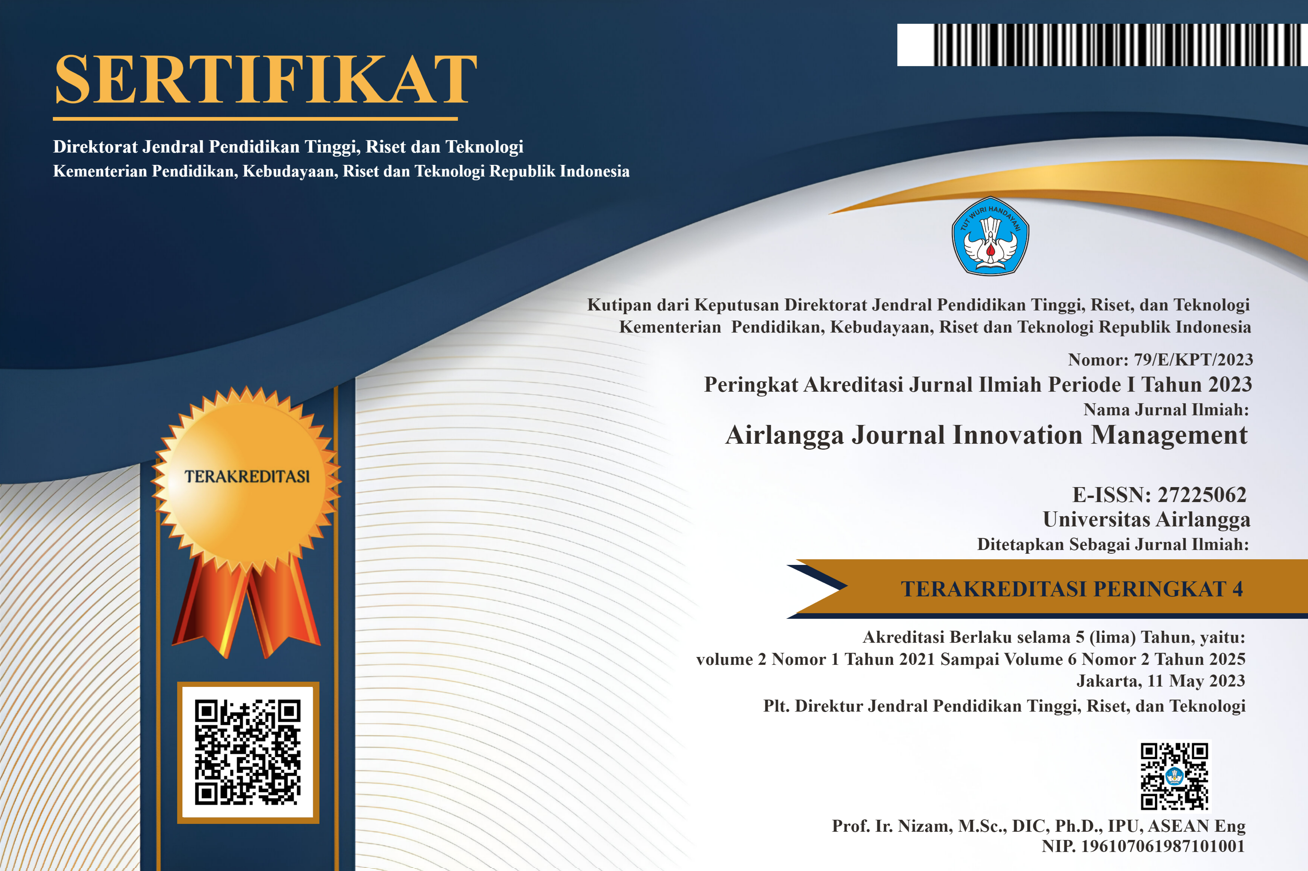SELF MARKETING OF ELDERLY-PRENEURS THROUGH SYMBOLIC INTERACTIONISM IN LUMAJANG
Downloads
The complexity of the needs requires everyone to work and make the right decisions in meeting the needs in order to ensure an effective and decent life. Self marketing is one of the efforts that can be done by an elderly person to support daily needs. This study aims to determine the meaning of the elderly entrepreneurial activity and to determine the self-marketing pattern of elderly-preneurs in Lumajang. This type of research is a descriptive qualitative research. Determination of informants in the study using purposive sampling method. The data analysis method uses four steps, there are data collection, data condensation, data presentation, and conclusions. This study concludes that there are various meanings of entrepreneurship for elderly including entrepreneurship as a fulfillment of economic needs, as a form of health resilience and as worship. As for the pattern of self-marketing that was found, as an optimization of symbols in influencing consumer behavior, place of business as a support for contrasting social class images, and the linearity of elderly products with local and traditional products. This research is expected to be a reference for science in field of inclusive marketing and as a reference for Government to improve an elderly friendly environment in Lumajang.
Agustiani. (2009). Psikologi Perkembangan (Pendekatan Ekologi Kaitannya dengan Konsep Diri dan Penyesuain Diri Remaja). Bandung: PT. Refika Aditama.
Aksan, N., Kisac, B., Aydin, M., & Demirbuken, S. (2009). Symbolic interaction theory. Procedia Social and Behavioral Sciences 1, 902–904.
Aprile, M. C., Caputo, V., Nayga, J.R.M. (2012). Consumers' valuation of food quality labels: the case of the European geographic indication and organic farming labels. International Journal of Consumer Studies 36, 158–165.
Armando, N.M. (2014). Psikologi Komunikasi. Universitas Terbuka: Jakarta.
BPS, Provinsi Jawa Timur. (2020). Profil Penduduk Lanjut Usia Provinsi Jawa Timur. Jawa Timur : Badan Pusat Statistik Provinsi Jawa Timur. (17 Mei 2022).
Dahlan, A.K.& Umrah, A.S. (2018). Kesehatan Lansia Kajian Teori Gerontologi dan Pendekatan Asuhan pada Lansia. Malang: Intimedia
Elliyana, E. Sulistiyono, D. (2020). Buku Ajar Kewirausahaan. Malang. Ahlimedia Press.
Giles, J., Wang, D., Cai, W. (2011). The Labor Supply and Retirement Behavior of China's Older Workers and Elderly in Comparative Perspective. IZA Discussion Paper, Germany.
Halabinsky, D. Potter, J. Kautonen, T. (2012). Entrepreneurial Activities in Europe: Policy Brief on Senior Entrepreneurship OECD Local Economic and Employment Development Division. Luxembourg: Publications Office of the European Union.
Hidayat, T. (2020). Analisis Pengaruh Produk, Harga, Promosi Dan Lokasi Terhadap Keputusan Pembelian. Jurnal Ilmu Manajemen, Volume 17, Nomor 2.
Ilham & Hermawati. (2018). Pengaruh Faktor Kelas Sosial Terhadap Perilaku Konsumen Dalam Pemilihan Pakaian Di Desa Lagego Kecamatan Burau Kabupaten Luwu Timur. DINAMIS- Journal of Islamic Management And Bussines. Vol. 1, No. 1.
Iswanti, S. (2001). Nilai dan pemberdayaan lansia dalam budaya Jawa (Tesis tidak diterbitkan). Program Pascasarjana UNY, Yogyakarta.
Izdiha, A. & Kalamika, A.M. (2018) Succesful Aging Di Yogyakarta : Bekerja Sebagai Optimalisasi Usia Tua. Welfare : Junal Ilmu Kesejahteraan Sosial Volume 7, Isues 1.
Josita, A. & Pribadi, M.A. (2021). Peran Interaksi Simbolik dalam Perencanaan Komunikasi Pemasaran di Era Pandemi (Studi Kasus Kopi Lain Hati Sukasari Bogor). Prologia Vol. 5, No. 1, Maret 2021, Hal 45-51.
Karni, A. (2019). Resiliensi Lansia Di Panti Jompo Bpplu Provinsi Bengkulu. International Seminar on Islamic Studies , IAIN Bengkulu , March 28 2019.124-133.
Kotler, P. & Amstrong, G. (2012). Marketing an Introduction. New Jersey: Pearson Prentice Hall, Inc.
Kotler, P., & Amstrong, G. (2016). Dasar-dasar Pemasaran. Jilid 1, Edisi Kesembilan. Jakarta: Erlangga.
Laksmi. (2017). Teori Interaksionisme Simbolik dalam Kajian Ilmu Perpustakaan dan Informasi. Journal Of Library and Information Science, 1(1), 121–138.
Loretto, W. & White, P. (2006). Employers? Attitdues, Practices and Policies Towards Older Workers. Human Resource Management Journal, Vol 16, no 3, pages 313–330.
Mahmuda, U & Jalal, M. (2021). Dukungan Sosial Dalam Menumbuhkan Kebermaknaan Hidup Lansia Di Panti Sosial Tresna Werdha Budi Mulia 3 Jakarta Selatan. SULUH, Vol. 8 No. 2.
Marwanti. (1997). Menanamkan Kebiasaan Mengkonsumsi Makanan Tradisional Sebagai Aset Budaya dan Wisata Boga. Cakrawala Pendidikan No. 2.
McNally, David & Speak, K.D. (2003). Be Your Own Brand: A Breakthrough Formula for Standing Out from the Crowd. San Francisco, CA: Berrett-Koehler Publishers.
Mead, G. H. (1934). Mind, self and society: From the standpoint of a social behaviorist. London: The University of Chicago Press.
Miles, M.B.,Huberman, M, dan Saldana, J. (2014). Qualitative Data Analisys-Third Edition. London: Sage Publication Ltd.
Montoya, P. & Vandehey, T. (2003). The Brand Called You: The Ultimate Brand-Building and Business Development Handbook to Transform Anyone into an Indispensable Personal Brand. Santa Ana, CA: Personal Branding Press.
Nurfaqih, M.I. & Fahmi, R.A. (2018). Social Entrepreneurship (Kewirausahaan Sosial) dalam Perspektif Ekonomi Islam. Working Paper Keuangan Publik Islam No. 8 Seri 1.
Priebe, J., and F. Howell. (2014). Old-Age Poverty In Indonesia: Empirical Evidence and Policy Options: A Role for Social Pensions. TNP2K Working Paper 07.
Riswandi. (2013). Psikologi Komunikasi. Yogyakarta: Graha Ilmu.
Ritzer, G. (2012). Teori Sosiologi: Dari Sosiologi Klasik Sampai Perkembangan Terakhir Posmodern. Yogyakarta : Pustaka Pelajar.
Roffer, R.F. (2002). Make a Name for Yourself: Eight Steps Every Woman Needs to Create a Personal Brand Strategy for Success. New York: Broadway.
Sari, E.P. & Nuryoto, S. (2002). Penerimaan Diri Pada Lanjut Usia Ditinjau Dari Kematangan Emosi. Jurnal Psikologi No. 2, 73 – 88.
Setyoningrum, A.A.D. & Herdawan, D. (2022). Motivasi dan Upaya Peningkatan Perekonomian melalui Wirausaha. Jurnal Manajemen dan Kewirausahaan 7(1), 37-47.
Shepherd, I.D.H. (2005). From Cattle and Coke to Charlie: Meeting the Challenge of Self Marketing and Personal Branding. Journal of Marketing Management, 21 (5/6), 589–606.
Sisyadi, B. & Pribadi, M.A. (2020). Interaksi Simbolik sebagai Pembentukan Perencanaan Komunikasi Pemasaran (Studi Etnografi pada PT. Inti Ozzigeno Nara Solusi). Prologia. Vol. 4, No. 1, Maret 2020, Hal 59–66.
Spillane, M. (2000). Branding Yourself: How to Look, Sound and Behave Your Way to Success. Basingstoke, England: Pan.
Suharti, Iswanti, S. & Triyanto, A. (2018). Pengembangan Model Kewirausahaan Bagi Insan Lanjut Usia. Jurnal Penelitian Humaniora, Vol. 23, No. 2.
Wijayanti, R. (2018). Membangun Entrepreneurship Islami dalam Perspektif Hadits. Cakrawala: Jurnal Studi Islam 37Vol. 13No. 1.

This work is licensed under a Creative Commons Attribution-NonCommercial-ShareAlike 4.0 International License.
- The journal allows authors to hold copyright without restrictions and retain publication rights without restrictions. The author retains the copyright and grants the first publication rights to the journal, with his work simultaneously licensed under the Creative Commons Attribution-NonCommercial-ShareAlike 4.0 International License (CC BY-NC-SA). This license allows others to share the work with acknowledgment of authorship and initial publication in this journal, provided that the work is not used for commercial purposes and that any derivative works must use the same license.
- Authors may enter into additional contractual agreements for non-exclusive distribution of the journal publication version (e.g., uploading it to an institutional repository or publishing it in book form), while still including acknowledgment of the initial publication in this journal.
- Authors are allowed and encouraged to upload their work online (e.g., in an institutional repository or personal website) before and during the submission process. This can support productive scientific exchanges as well as increase citations to published works.

AJIM by UNAIR is licensed under a Creative Commons Attribution-NonCommercial-ShareAlike 4.0 International License.





















